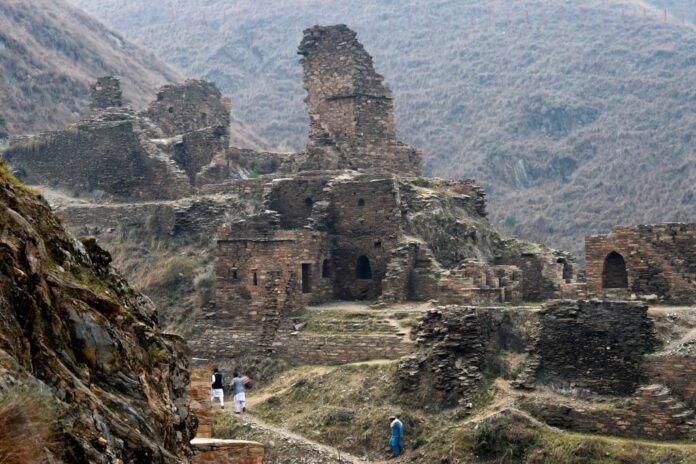KARACHI: Massive floods caused by deluges of water falling from the sky have wreaked unprecedented havoc across Pakistan, inundating a third of the country and killing nearly 1,300 people since mid-June.
Apart from massive human and infrastructure losses, the nation risks losing its archaeological treasure, which includes remnants of the thousands-year-old Mohinjo Daro and Mahargarh civilisations.
Mohinjo Daro, located in the Larkana district of Sindh, has been hit particularly hard by the country’s most destructive monsoon spells and floods in recent history.
The floodwaters surrounding the 5,000-year-old iconic site have damaged several excavated portions, with water seeping through and creating furrows.
Rain and flood waters seeping into the ground are tilting the walls of the heritage site’s prehistoric houses, which date back to 2,500 BC and are the last surviving remnants of the Indus Valley Civilisation.
This alarming development, according to archaeologists, could potentially lead to the walls completely crumbling and collapsing.
Apart from Mohinjo Daro, Sindh is strewn with heritage sites, only a few of which have been spared by the ravaging floods.
The 18th century Kotdiji Fort and Faiz Mahal (palace) built during the Talpur dynasty’s reign over the then-independent state that is now the district of Khairpur, located some 450 kilometers (280 miles) from Karachi, have also conceded considerable damage from the unprecedented rains and floods.
Makli, one of the world’s largest necropolises, roughly 100 kilometers (62 miles) east of Karachi, is also submerged.
Located on a Makli foothill and listed on UNESCO’s list of protected heritage sites in 1981, the necropolis contains over 20,000 tombs, pavilions, and open graves of rulers, army generals, poets, architects, and unidentified warriors going back to the 14th century.
Many other centuries-old graveyards, tombs, structures, and forts, notably the Ranikot Fort, known as the Great Wall of Sindh because of its structural resemblance to China’s Great Wall, have also been flooded.
Several Buddhist and Hindu sacred sites have also been damaged across the province.
According to Hamid Akhund, secretary general of the Endowment Fund Trust, a semi-government organisation involved in the preservation of heritage sites in Sindh, not a single heritage property survives intact outside of Karachi.
“The damage is massive due to the Biblical proportions (of the flood). A similar flood, I believe, decimated Mohinjo Daro thousands of years ago,” Akhund told Anadolu Agency.
“The rains and floods almost damaged everything in days that we had restored for years,” he added.
Furthermore, major damage to the archaeological treasure has occurred in Balochistan, which is home to several archaeological sites over 5,000 years old, as a result of weeks-long torrential rains and floods.
Speaking to Anadolu Agency, Panah Baloch, a researcher and historian based in the provincial capital of Quetta, observed that the latest floods have ruined many “already neglected” archaeological sites across Balochistan.
He noted that the most recent floods worsened the damage that soil erosion had already done to the 9,000-year-old Mahargarh site in Balochistan’s eastern Naseerabad district.
Several historic forts and tombs dating back over 4,000 years, including Perak and Noshehra, have also been damaged in the districts of Naseerabad, Khuzdar, Saurab, and Naal, he said.
In contrast, archaeology sites across Khyber Pakhtunkhawa, which borders neighboring Afghanistan, remain largely safe despite massive rains and flash floods.
“There are no major losses to the archaeology and heritage sites in KP with the exception of the destruction of roads leading to these sites,” said Fawad Khan, an official with the provincial archaeology department.
Speaking to Anadolu Agency, he said that unlike in Sindh and Balochistan, the floods have basically damaged the population and infrastructure located near the rivers and streams.
The province is home to 70 percent of the sites in the country sacred to Sikhs and Buddhists.
Once known as the heart of the Gandhara civilisation, Takht-i-Bhai (throne of origins), a small scenic town located some 160 kilometers (99 miles) from the capital Islamabad, is the most visited site by Buddhists, who flock to see the ancient monastery dating back to the 1st century AD.
For centuries, the region in northern Afghanistan and Pakistan served as the center of Gandhara civilisation.
Uphill task
Pakistan is home to a plethora of revered pilgrimage sites, some of which date back 5,000 years, for followers of not only Hinduism, Buddhism, and Sikhism, but also some pre-historic faiths such as the Aryan, Barhaman, and ancient Iranian and Greek religions.
Archaeologists consider restoring damaged heritage sites to be an “uphill task.”
“There is no doubt that this is an uphill task. “The government must take this seriously,” said Akhund, a former secretary of Sindh’s Culture and Heritage Department.
Several heritage buildings have developed normal cracks and damages that are repairable, he asserted.
However, he added that frescoes in several buildings, most notably the 18th-century Shahi Mahal (Royal Palace) and White Palace in Khairpur, are “irreparable.”
“This kind of art no longer exists,” he added, explaining that the craftsmen who did the job were brought to Sindh from parts of India.
The task is still doable to a large extent, according to him, but will cost “a lot.”
In Sindh alone, he estimated that at least Rs500 million (approximately $2.28 million) would be required for the re-restoration exercise.
Echoing Akhund’s view, Baloch, the Quetta-based researcher, urged the government to “immediately” appoint supervisors to contain the “archaeological theft.”
“Local people may steal or pick up and sell the archaeological treasure while taking advantage of floods as these sites are unsupervised,” he worried.
“The actual damage has yet to be estimated as many of the (inundated) heritage sites are still unreachable because of the massive floods sweeping away roads and bridges,” he said.























